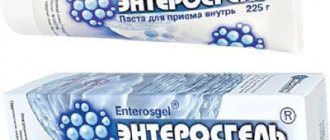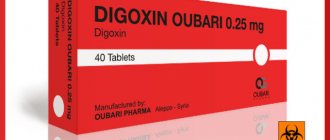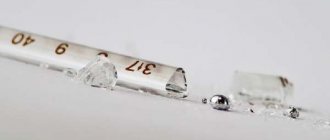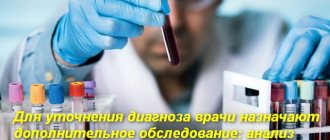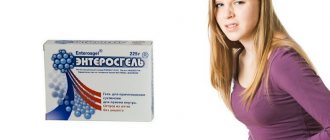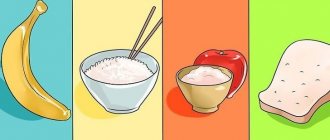Food poisoning occurs as a result of consuming low-quality and expired food products that contain harmful bacteria or toxic substances. When they enter the body, they begin to actively multiply.
Poor quality food is a common cause of poisoning
This condition is not contagious, is accompanied by deterioration of the digestive system and is characterized by the presence of symptoms such as nausea, vomiting, constipation or diarrhea.
Etiology of food poisoning
Food poisoning includes all types of digestive disorders that occur when eating low-quality food. The causative agent of the disease is:
- Pathogenic microorganisms leading to intestinal infection . Pathogens (most often salmonella, staphylococcus, and E. coli) can be found not only in expired or spoiled food, but also in fresh food. They penetrate food products at different stages - from production to serving. For example, when using low-quality raw materials in cooking, violating storage standards, or failing to comply with sanitation rules during preparation of a dish.
Meet Salmonella, Staphylococcus and Botulism under the Microscope
- Bacterial toxins leading to foodborne illnesses . At the same time, the microorganisms themselves practically do not participate in the pathological process. This is why antibiotics are useless for disorders caused by eating food contaminated with bacterial toxins.
- Harmful compounds of non-microbial origin that cause non-infectious toxicoses . Such substances, in particular, include poisons contained in certain types of mushrooms, berries, and plants. These toxicoses require immediate medical attention as they can lead to coma and death.
The most common food sources of infections include:
- poorly washed greens and vegetables – noroviruses;
- poultry meat, eggs – salmonella;
- dairy and fermented milk products – campylobacteria.
The first symptoms of foodborne illness and non-microbial poisoning appear 1–12 hours after consuming low-quality or expired food. The exact period depends on the state of the immune system, the amount eaten and the degree of its toxicity. In adults, signs of the disease appear later than in children.
Intestinal infections develop more slowly. From the moment pathogenic agents enter the body, it can take from several days to a month - this period is called the incubation period.
The main difference between infectious food poisoning and toxic food poisoning is an increase in body temperature. With salmonellosis it can reach 40 °C, and with “ordinary” food poisoning it rarely rises to 38 °C.
In case of severe intoxication, for example, with poisonous mushrooms, the patient may lose consciousness and fall into a coma. There are frequent cases of hallucinations and epileptic seizures.
Replenishing lost fluid
After providing first aid, it is necessary to replenish the lost fluid. For this purpose, drinking plenty of fluids is recommended. In this case, non-carbonated bottled or regular filtered boiled water and warm, weak green tea are best suited. If the child does not refuse such drinking, ordinary water can be slightly salted. This water will help get rid of toxins that were not eliminated during gastric lavage or diarrhea.
It is necessary to replenish the loss of fluid in the body
At the same time, it is important to comply with the norms of replenishment of fluid, not exceeding the amount of water drunk required for a certain age. It is best to combine fluid intake with medications such as Oralit or any analogues of this medication. In order not to burden the body with medications, you can use other equally effective means. Lemon juice, which can be added to your drink, is excellent at killing harmful bacteria. Another option for taking sour liquid: mix juice from half a fruit with 1 teaspoon of honey and take half an hour before meals.
To avoid the recurrence of symptoms, you must follow a diet. In the first days after poisoning, it is better to give the child white bread crackers, bananas, oatmeal, which have a beneficial effect on the stomach, rehabilitating its microflora naturally.
After the gastrointestinal tract has restored its function, you can gradually move on to coarser dishes that require long-term digestion. At first, it is better to completely exclude dairy and bakery products. Instead, it is better to form the basis of the diet from boiled potatoes and rice, stewed lean meat.
What happens in the body during food poisoning
When foreign agents in the form of bacteria, microbial toxins or poisons enter the body, they irritate the nerve receptors lining the walls of the stomach, which leads to contraction of the muscular sphincter in the duodenum. The esophagus expands and contracts. As a result, the peristalsis of the stomach is disrupted, and the food in it moves in the opposite direction - vomiting occurs.
Nausea is a protective physiological mechanism aimed at removing toxins from the stomach and preventing their adsorption into the general bloodstream. Diarrhea develops for the same purpose . Both processes lead to dehydration and loss of minerals, which has consequences:
- disturbance of central nervous system activity – lethargy, dizziness;
- deterioration of blood supply to tissues - pale and dry skin;
- abnormal heart rhythm;
- the occurrence of muscle cramps.
Under the influence of toxins, the mucous membrane of the stomach, liver, and pancreas can become inflamed. The process is accompanied by pain in the affected area. With increased gas formation, intestinal colic is observed.
How to distinguish food poisoning from other diseases?
Symptoms of food poisoning are nonspecific, as they also occur with other diseases. Vomiting can be a harbinger of the flu, pain in the stomach - pancreatitis. High temperature and cramps in the right side - appendicitis. And diarrhea is a rotavirus infection. But if all of the listed manifestations occur at the same time, most likely the cause is food intoxication. Another sign that allows you to exclude the possibility of developing other diseases is the absence of symptoms atypical for poisoning: cough, runny nose, sore throat.
Nutritional Features
During therapy you need to adhere to a gentle diet. During the first 24 hours, only liquids can be consumed. On the second and third days you need to eat in small portions, but often. Food should be warm, non-spicy, low-fat and neutral in taste. It is advisable to steam food.
Examples of suitable dishes:
- chicken bouillon;
- oatmeal;
- rice;
- buckwheat;
- baked vegetables;
- boiled poultry meat;
- poached fish.
Doctors recommend chicken broth for poisoning
Until complete recovery, you should avoid store-bought processed foods, dairy products, coffee, freshly squeezed juices, confectionery, chocolate, and honey.
Classification and examples of drugs
It is up to the doctor to decide which tablets to use in therapy for foodborne infections. Taking inappropriate antibiotics can lead to worsening intoxication of the body and the development of severe side effects.
In case of a mild form of food poisoning, it is permissible to choose medications yourself. Usually such disorders go away on their own after a few days. But it’s still better to help the body recover.
Sorbents
Sorbents are used to cleanse the digestive tract of toxins and poisons. Drugs in this group adsorb harmful substances on their surface and remove them from the body. As a result, the severity of intoxication decreases, nausea subsides, and body temperature drops when poisoned by toxins.
The faster the sorbent is taken, the higher the likelihood that toxins will not have time to penetrate the bloodstream. Their use on the second day and later is unjustified.
Names of popular sorbents:
- Activated carbon;
- Polysorb;
- Smecta;
- Enterosgel;
- Sorbex.
Activated carbon for food poisoning is best taken in the form of an introductory suspension. To do this, crush 10 tablets and mix with water. The resulting mixture should be drunk once, preferably after gastric lavage.
Rehydration preparations
To prevent dehydration of the body due to frequent bowel movements and vomiting and to prevent an increase in acidity in the gastrointestinal tract, drugs are used to restore water and electrolyte balance. They contain sodium and potassium salts. They are produced in the form of powders for dilution. Ready-made solutions are taken orally or administered intravenously using droppers.
What to drink if you have food poisoning:
- Regidron;
- Re-sol;
- Normohydron;
- Regesol.
Enzymes
To restore the functions of the gastrointestinal tract, drugs based on digestive enzymes are used. They break down proteins, carbohydrates and fats, which facilitates the process of digesting food.
Examples of enzyme preparations:
- Mezim;
- Festal;
- Pancreatin;
- Innozim.
Mezim is taken orally during a meal, 1-2 tablets without chewing. The treatment course varies from several days to several months, depending on the degree of indigestion.
Antispasmodics
Pain arising from spasms of the muscles of the digestive tract can be relieved with the help of antispasmodics based on drotaverine and papaverine. Taking them without consulting your doctor is extremely dangerous. Symptoms of food poisoning are similar to those of appendicitis; pain relief will blur the clinical picture and make it difficult to make a correct diagnosis.
What to take if you have food poisoning:
- No-spa – 1-2 tablets 2-3 times a day, but not more than 80 mg;
- Drotaverine – 1-2 tablets 3 times a day, but not more than 200 mg.
Gastroprotectors
For irritable bowel syndrome, which often accompanies diarrhea, and to prevent inflammation of the stomach walls, you can take gastroprotectors.
- De-Nol;
- Omez;
- Omeprazole;
- Almagel.
Probiotics
To eliminate the imbalance of microflora in the intestines, probiotics are prescribed. They contain pure cultures of beneficial bacteria. Examples of probiotics and rules for taking them:
- Linex – 2 capsules 3 times a day, washed down with a small amount of water;
- Bifiform - 1 capsule 4 times a day until stool normalizes, and then 2 capsules a day until the symptoms of poisoning completely disappear.
Antidiarrheal and antiemetic drugs
Antiemetic and antidiarrheal drugs are prescribed as a last resort : when there is a threat of severe dehydration, and only if the bulk of the toxins have already left the body naturally. Otherwise, they will contribute to the absorption of harmful substances into the blood, stopping the process of their removal from the body, and worsening intoxication. Medicines inhibit intestinal or stomach motility. As a result, the urge to vomit and defecate stops.
Examples of drugs:
- Antiemetics - Motiluim, Cerucal;
- Antidiarrheal – Loperamide.
Loperamide is taken in the amount of 2 tablets at the beginning of therapy and 1 thereafter after each loose stool. The maximum treatment period is 48 hours.
Antibiotics
Antibacterial tablets for food poisoning are prescribed only if the illness is caused by bacteria. In case of toxic infections, they will only aggravate the patient’s condition by disrupting the intestinal microflora. Antibiotic names:
- Ofloxacin;
- Furazolidone;
- Ciprofloxacin;
- Metronidazole;
- Ceftriaxone.
How to relieve symptoms
There are sure ways to relieve the symptoms of poisoning. By following them, you can improve your condition before the doctors arrive or, if the poisoning is not severe, completely eliminate the signs of intoxication.
Step 1: Stop eating solid foods. It can increase diarrhea and vomiting, which already haunt the poisoning. It is advisable to eat in small portions so as not to overload the stomach. But as soon as your condition improves, you can get back on track and eat regular food in normal quantities. Of course, you must avoid eating foods that cause poisoning. If you are not yet completely sure what exactly caused this condition, try to exclude from your diet all the foods that you ate on the day of poisoning.
Stop eating solid foods
In case of poisoning, broths and soups are very useful, but if they are consumed constantly, the patient may get tired of the monotony. In this case, you can eat toast, boiled rice or banana.
Step 2: Rehydrate. It is no secret that frequent vomiting and diarrhea are accompanied by loss of fluid, so in case of poisoning it is very important to drink water to prevent dehydration. You can also drink various drinks, for example, herbal tea, ginger infusion. With their help, you can eliminate nausea, calm the stomach and cope with dehydration.
Drink plenty of water
In case of poisoning, it is highly not recommended to drink drinks that dry out the body. We are talking about alcoholic beverages and coffee.
Step 3. As a rule, dehydration is accompanied not only by the loss of fluid, but also by various nutrients. To restore electrolyte reserves, you need to drink special solutions that can be purchased at the pharmacy. The most common ones include Zero, Pedialite and Gatorade.
Replenish electrolytes
Step 4. Take enough time to rest. When symptoms of food poisoning appear, the patient usually feels general weakness and fatigue. Good rest will allow the body to recover faster.
Get more rest
Step 5. Do not self-medicate. Improper use of pharmaceutical drugs that are available without a prescription can not only slow down the healing process, but also worsen the condition.
Don't self-medicate
Forms of release of drugs: which are better?
How effective a medicine for food poisoning will be depends on the form in which it is released. They come in several types:
- tablets and capsules;
- injections for intramuscular administration;
- solutions for droppers;
- powders for dilution.
The tablets are dosed so they are easy to take. They are covered with a special shell, which dissolves only in an acidic or alkaline environment, due to which they act locally - in the desired area of the digestive tract.
The main disadvantage of tablets is that after they dissolve in the stomach, solutions with a high concentration of active substances are formed, which provoke irritation of the mucous membranes of the digestive organs. In addition, they take a long time to dissolve in the gastrointestinal tract, which makes their use inappropriate when it is necessary to provide emergency assistance.
Dilution powders act like tablets, but have several advantages:
- fast absorption;
- possibility of self-dosing;
- less harm to the gastrointestinal tract.
The fastest way to administer medications for food poisoning is through IVs. The active components of saline solutions penetrate directly into the bloodstream, which promotes a speedy recovery.
Droppers can be done at home, but the first independent procedure is best done under the supervision of a healthcare professional . They are prescribed for severe pathogenesis of poisoning:
- temperature above 39 °C;
- severe pain in the abdominal area;
- frequent vomiting - more than 10 times a day;
- visual impairment;
- lethargy;
- convulsions;
- difficulty breathing;
- surges in blood pressure;
- loss of consciousness.
IV
In case of food intoxication, infusion therapy can be a key point. With the help of such administration of medications, homeostasis disorders can be eliminated in the shortest possible time.
Timely infusion intervention for food intoxication allows you to achieve:
- Replenishment of blood circulation volumes;
- Normalization of blood pressure;
- Perfusion improvements of key intraorganic functions;
- Destruction of pathogenetic shock reactions;
- Elimination of microcirculatory insufficiency;
- Minimal toxic effects, and their accelerated removal from the body;
- Control over blood clotting processes;
- Quick response to any deterioration in the patient’s well-being;
- Drug support of renal, pulmonary and cardiac activity.
Infusion therapy is prescribed exclusively by doctors; independent use of IVs is unacceptable.
Folk remedies
For mild forms of food poisoning, you can use folk remedies. But not all of them are effective, and some can even lead to dire consequences. Therefore, before starting self-medication, consult your doctor.
Examples of folk recipes:
- Cinnamon infusion . Has an antispasmodic effect. Preparation: 0.5 tsp. ground spices, pour 200 ml of boiling water, leave for 15 minutes, filter. Drink in small sips. The daily norm is 1.5 l.
- A decoction of honey and dill . Promotes the removal of toxins, replenishes the lack of potassium during dehydration and reduces the severity of vomiting without stopping them. Preparation: 1 tsp. dill is immersed in 300 ml of boiling water, left for 5 minutes, boiled for another 60 seconds, filtered, added 1 tsp. honey and stir. Drink in small sips on the first day.
- Yarrow decoction cleanses the body of toxins. Preparation: mix 1 tsp. plants with 500 ml of boiling water, leave for 10 minutes, filter. The finished infusion is drunk 5 times over 24 hours.
When should you consult a doctor?
Be sure to seek medical attention if the frequency of vomiting and diarrhea does not decrease after a few days. And also if the following symptoms occur:
- pain in the kidney area;
- severe migraine;
- heat;
- excessive weakness;
- feeling of suffocation.
If you are poisoned by poisonous foods or plants, you must urgently rinse your stomach and call an ambulance . Symptoms with such intoxication develop rapidly, so you should not wait until the victim loses consciousness or falls into a coma.
You cannot self-medicate when the clinical picture of food poisoning indicates the development of an intestinal infection. Especially if it occurs after eating homemade canned food - the main source of botulinum toxin. Such intoxications often cause death.
Tablets for intoxication for children
Poisoning in children is more serious and faster than in adults.
What to do in such a situation? Tablets for children cannot be selected independently. The choice of drug is made by the doctor after conducting an examination and assessing the child’s condition. In case of intoxication in childhood, gentle medications with a minimum number of contraindications and side effects are chosen.
Allowed:
- Activated carbon,
- Bifiform,
- Regidron,
- Smecta,
- Polysorb.
Antibacterial, painkillers and other tablets are given as prescribed, strictly following the instructions. Self-administration can cause serious complications. In addition to taking medications, it is recommended to follow a drinking regimen and diet.
